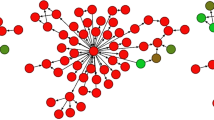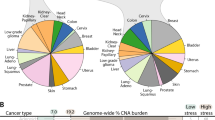Abstract
The transcriptional program regulated by the tumor suppressor p53 was analysed using oligonucleotide microarrays. A human lung cancer cell line that expresses the temperature sensitive murine p53 was utilized to quantitate mRNA levels of various genes at different time points after shifting the temperature to 32°C. Inhibition of protein synthesis by cycloheximide (CHX) was used to distinguish between primary and secondary target genes regulated by p53. In the absence of CHX, 259 and 125 genes were up or down-regulated respectively; only 38 and 24 of these genes were up and down-regulated by p53 also in the presence of CHX and are considered primary targets in this cell line. Cluster analysis of these data using the super paramagnetic clustering (SPC) algorithm demonstrate that the primary genes can be distinguished as a single cluster among a large pool of p53 regulated genes. This procedure identified additional genes that co-cluster with the primary targets and can also be classified as such genes. In addition to cell cycle (e.g. p21, TGF-β, Cyclin E) and apoptosis (e.g. Fas, Bak, IAP) related genes, the primary targets of p53 include genes involved in many aspects of cell function, including cell adhesion (e.g. Thymosin, Smoothelin), signaling (e.g. H-Ras, Diacylglycerol kinase), transcription (e.g. ATF3, LISCH7), neuronal growth (e.g. Ninjurin, NSCL2) and DNA repair (e.g. BTG2, DDB2). The results suggest that p53 activates concerted opposing signals and exerts its effect through a diverse network of transcriptional changes that collectively alter the cell phenotype in response to stress.
This is a preview of subscription content, access via your institution
Access options
Subscribe to this journal
Receive 50 print issues and online access
$259.00 per year
only $5.18 per issue
Buy this article
- Purchase on Springer Link
- Instant access to full article PDF
Prices may be subject to local taxes which are calculated during checkout






Similar content being viewed by others
References
Ausubel FM, Brent R, Kingston RE, Moore DD, Seidman JG, Smith JA, Struhl K . 1990 Current Protocols in Molecular Biology Green/Wiley Interscience, New York
Blatt M, Wiseman S, Domany E . 1996 Physical Rev. Lett. 76: 3251–3254
Coller H, Grandori C, Tamayo P, Colbert T, Lander ES, Eisenman RN, Golub TD . 2000 Proc. Natl. Acad. Sci. USA 97: 3260–3265
El-Deiry WS, Kern SE, Pietenpol JA, Kinzler KW, Vogelstein B . 1992 Nat. Genet. 1: 45–49
El-Deiry WS . 1998 Sem. Cancer Biol. 8: 345–357
Getz G, Levine E, Domany E, Zhang MQ . 2000 Physica A. 279: 457–464
Ginsberg D, Michalovitz D, Ginsberg D, Oren M . 1991 Mol. Cell Biol. 11: 582–585
Hannon GJ, Beach D . 1994 Nature 371: 257–261
Haupt Y, Maya R, Kazaz A, Oren M . 1997 Nature 387: 296–299
Jimenez GS, Nister M, Stommel JM. Beeche M, Barcarse EA, Zhang X-Q, O'Gorman S, Wahl GM . 2000 Nat. Genet. 26: 37–43
Kaminski N, Allard JD, Pittet JF, Zuo F, Griffiths MJD, Morris D, Huang X, Sheppard D, Heller RA . 2000 Proc. Natl. Acad. Sci. USA 97: 1778–1783
Kannan K, Amariglio N, Rechavi G, Givol D . 2000 FEBS Lett. 470: 77–82
Komarova EA, Diatchenko L, Tokhlin OW, Hill JE, Wang ZJ, Krivokrysenko VI, Feinstein E, Gudkov AV . 1998 Oncogene 17: 1089–1096
Kubbutat MH, Jones SN, Vousden KH . 1997 Nature 387: 299–303
Levine AJ . 1997 Cell 88: 323–331
Massague J, Blain SW, Lo SR . 2000 Cell 103: 295–309
Michalovitz D, Halevy O, Oren M . 1990 Cell 62: 671–680
Michieli P, Chedid M, Lin D, Pierce JH, Mercer WE, Givol D . 1994 Cancer Res. 54: 3391–3395
Oda K, Arakawa H, Tanaka T, Matsuda K, Tanikawa C, Morit T, Nishimori H, Tamai K, Tokino T, Nakamura Y, Taya Y . 2000 Cell 102: 849–862
O'Hagan RC, Schreiber-Agus N, Chen K, David G, Engelman JA, Schwab R, Alland L, Thomson C, Ronning DR, Sacchettini JC, Meltzer P, DePinho RA . 2000 Nat. Genet. 24: 113–119
Scherer SJ, Maier SM, Seifert M, Hanselman RG, Zang KD, Muller-Hemerling HK, Angel P, Walter C, Schartl M . 2000 J. Biol. Chem. 275: 37469–37473
Sherlock G . 2000 Curr. Opin. Immunol. 12: 201–205
Shivakumar CV, Brown DR, Deb S, Deb SP . 1995 Mol. Cell Biol. 15: 6785–6793
Tan M, Wang Y, Guan K, Sun Y . 2000 Proc. Natl. Acad. Sci. USA 97: 109–114
Tang B, Bottinger EP, Jakowlew SB, Bagnall KM, Mariano J, Anver MR, Letterio JJ, Wakefield LM . 1998 Nat. Med. 4: 802–807
Vousden KH . 2000 Cell 103: 691–694
Young RA . 2000 Cell 102: 9–15
Yu J, Zhang L, Hwang PM, Rago C, Kinzler KW, Vogelstein B . 1999 Proc. Natl. Acad. Sci. USA 96: 14517–14522
Zhan Q, Chen IT, Antinore MJ, Fornace AJ . 1998 Mol. Cell Biol. 18: 2768–2778
Zhao R, Gish K, Murphy M, Yin Y, Notterman D, Hoffman WH, Tom E, Mack DH, Levine AJ . 2000 Genes Dev. 14: 981–993
Acknowledgements
We are grateful for the Arison Dorsman family's donation to the Center of DNA Chips in Pediatric Oncology. This work was supported in part by the Yad Abraham Research Center for Cancer Diagnosis and Therapy, the Rich Foundation for Leukemia Research and the Germany-Israel Science Foundation (GIF). G Rechavi holds the Gregorio and Dora Shapiro Chair for Hematologic Malignancies, Sackler School of Medicine, Tel Aviv University. We are thankful to the Crown Human Genome Center of the Weizmann Institute for the help received.
Author information
Authors and Affiliations
Rights and permissions
About this article
Cite this article
Kannan, K., Amariglio, N., Rechavi, G. et al. DNA microarrays identification of primary and secondary target genes regulated by p53. Oncogene 20, 2225–2234 (2001). https://doi.org/10.1038/sj.onc.1204319
Received:
Revised:
Accepted:
Issue Date:
DOI: https://doi.org/10.1038/sj.onc.1204319
Keywords
This article is cited by
-
DDB2 and MDM2 genes are promising markers for radiation diagnosis and estimation of radiation dose independent of trauma and burns
Functional & Integrative Genomics (2023)
-
Mutual exclusivity of ESR1 and TP53 mutations in endocrine resistant metastatic breast cancer
npj Breast Cancer (2022)
-
RBCK1 promotes p53 degradation via ubiquitination in renal cell carcinoma
Cell Death & Disease (2019)
-
TIS21/BTG2 inhibits breast cancer growth and progression by differential regulation of mTORc1 and mTORc2–AKT1–NFAT1–PHLPP2 signaling axis
Journal of Cancer Research and Clinical Oncology (2018)
-
The Expression of IGFBP6 after Spinal Cord Injury: Implications for Neuronal Apoptosis
Neurochemical Research (2017)



